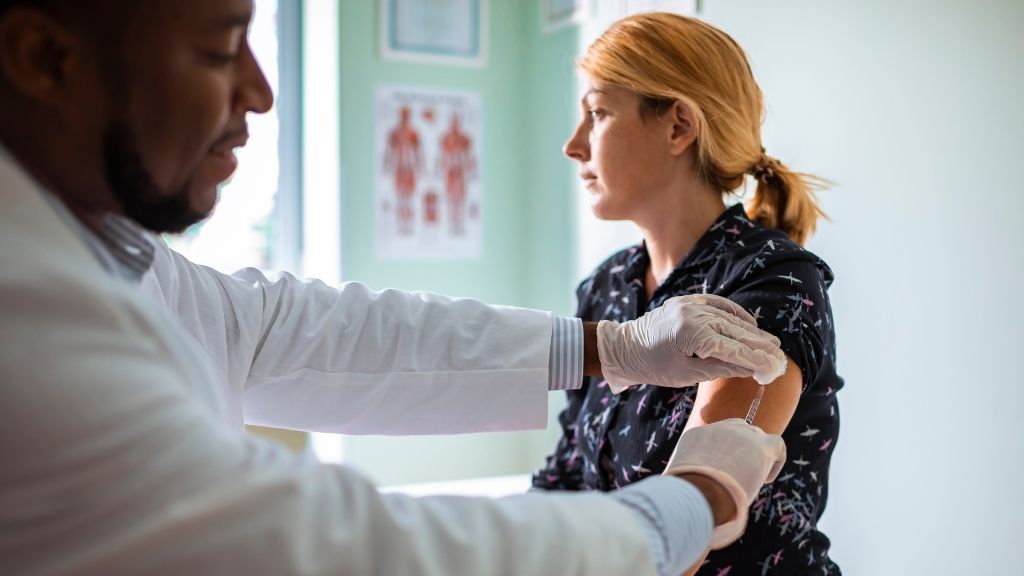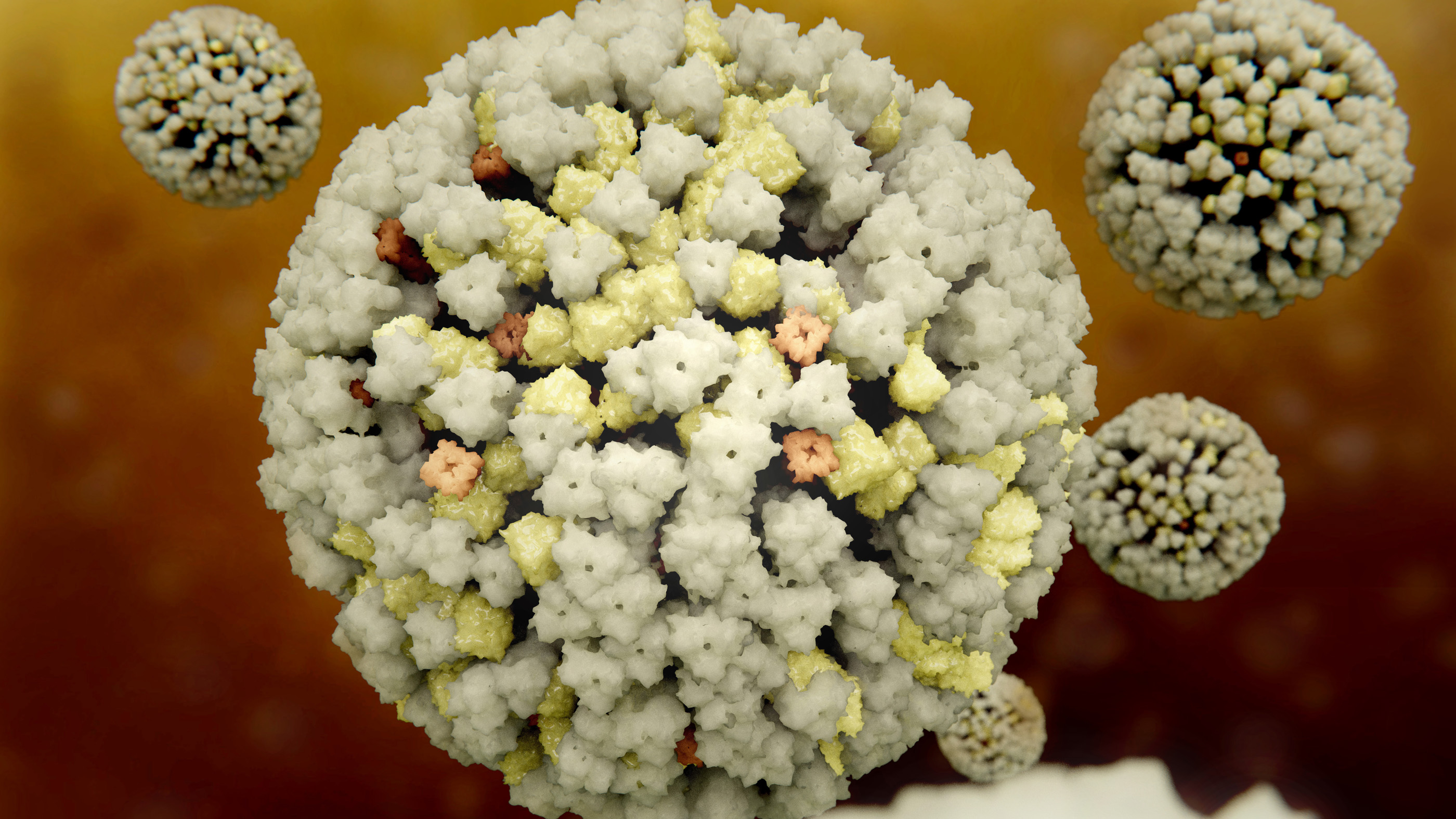
Why is the flu shot less effective than other vaccines?

The effectiveness of the seasonal flu shot pales in comparison to knockout shots like the MMR vaccine, which is about 97% effective at preventing measles, 88% effective at preventing mumps and 97% effective against rubella. By contrast, flu shots typically range from 40% to 60% effective, and sometimes their effectiveness dips as low as 10%.
But why are flu shots less effective than other commonly used vaccines? A lot of it comes down to the rapid mutation of influenza viruses and the uncertainty around which strains might be circulating when flu season rolls around, experts told Live Science. And some of the vaccine's flaws may stem from how the shot is manufactured and the specific parts of the influenza virus it targets.
But although the flu shot isn't perfect, it still offers enough protection that the shot is worth getting, Live Science previously reported.
Related: The flu shot isn't that effective. Here's why you should still get it.
Picking the right strains
The seasonal flu shot typically trains the body to fight four types of influenza virus, according to the Centers for Disease Control and Prevention (CDC): two influenza A viruses of the subtypes H1N1 and H3N2, and two influenza B viruses from the so-called Victoria and Yamagata lineages, which refer to branches of the influenza family tree. These influenza viruses mutate rapidly from year to year, meaning their genetic code changes and the proteins that appear on their outer surfaces change rapidly, too.
The flu shot works by training the immune system to recognize one of these surface proteins, called hemagglutinin (HA), which juts off the virus "like a lollipop on a stick," said Dr. William Schaffner, an infectious disease specialist at Vanderbilt University in Tennessee. Similar to the novel coronavirus's infamous spike protein, the HA protein enables influenza viruses to bind to and infiltrate cells to infect them. And the HA protein mutates rapidly, essentially doing a costume change every year and thus making it hard for the immune system to recognize it.
Another challenge is that flu shots must be manufactured and ready to go before flu season, so scientists use various strategies to predict which flu strains will be circulating in the coming months.
Sign up for the Live Science daily newsletter now
Get the world’s most fascinating discoveries delivered straight to your inbox.
"You try to anticipate which strains are going to be active during your winter, early," Schaffner said. "But we have to project, because it takes time to make the vaccine." And even as the vaccine is being prepped, the circulating viruses can keep on mutating, sometimes to the point that they no longer match the shots well. And by the time flu season begins, the influenza strains scientists thought would be most prevalent can sometimes be overtaken by other versions of the viruses.
To predict which flu strains will dominate in the upcoming season, more than 140 national influenza centers in 113 countries collect swab samples from people who get flu-like sicknesses throughout the year, identifying those who actually caught influenza, according to Scientific American. Five World Health Organization-affiliated centers then do gene sequencing of the samples, characterize the proteins that lie on the viral surface, and run laboratory tests to see how well past vaccines neutralize the circulating flu strains, according to the CDC. They also determine which strains appear to be making the most people sick, and how fast the strains are spreading.
Related: Are viruses alive?

In February, consultants from each center come up with a recommendation for which strains to include for the Northern Hemisphere's flu vaccine for the upcoming winter. In September, they do the same for the Southern Hemisphere.
"Sometimes, the choice is right on target," Schaffner said. And then "there are other times that the flu manages to evade our predictions."
That said, even when there's a "good match" between the vaccine strains and circulating strains, the shots only tend to be about 40% to 60% effective. This modest effectiveness may be related to the fact that the shots target only the HA protein, rather than multiple spots on the influenza virus, and that the human immune system can sometimes be undermined by its previous exposures to the flu, Science magazine reported.
The natural immune response to an influenza infection involves generating antibodies against multiple proteins on the viral surface, not just HA, according to a 2013 report in Clinical Microbiology Reviews. The vaccines, by comparison, primarily generate antibodies against the HA protein, and it's unclear if targeting additional surface proteins could boost the shots' effectiveness, Science magazine reported.
Our first exposures to the flu in childhood may also bias how the immune system responds to vaccination, sometimes to our detriment, according to Science. After its first flu exposure, the body generates long-lived memory B cells, immune cells that remember the virus and can reactivate to produce more antibodies in the future. Some evidence suggests that later, if one is vaccinated against a similar — but not identical — flu virus to the first one they encountered, the body may reactivate these memory B cells, which crank out antibodies that miss their intended target.
Many flu vaccines are tested in ferrets that have never been exposed to flu before, so it's difficult to know whether the shot will work similarly in humans who've likely encountered flu viruses several times before.
Problems with manufacturing?
The way most flu shots are produced may also undermine their success.
Most flu vaccines contain viruses that have been grown in chicken eggs, as part of the manufacturing process. "You have to modify the virus a little bit so it grows abundantly in eggs," Schaffner explained. And there's some evidence that, as the egg-borne virus replicates, it may pick up mutations that cause its genetics to diverge from the circulating flu strains. So when the egg-borne viruses are then killed or weakened for use in flu vaccines, they no longer match flu viruses in the wild.
In general, influenza A(H3N2) viruses mutate the fastest out of the flu subtypes included in the vaccines, so influenza A(H3N2) viruses are the most likely to produce "escape mutants" that can evade vaccines. A(H3N2) also appears most prone to so-called egg-adapted changes, the CDC states. These factors may explain why flu shots are typically less protective against H3N2.
Although most flu vaccines start out in eggs, not all do, according to the CDC. Some of the viruses used in inactivated flu shots — which contain "dead" flu viruses — are grown in mammalian cells, and so-called recombinant flu vaccines don't require live virus samples at all.
For the recombinant vaccines, scientists build a synthetic gene that codes for the HA protein and then produce the protein inside baculoviruses, which naturally infect insects. Some studies hint that genetically engineered HA may provide better protection against influenza than egg-grown viruses, Science magazine reported, but Schaffner said this still needs to be confirmed with further research.
How to improve the flu shot
Many groups are currently working on new-and-improved flu vaccines that aim to provide more protection, and some may not need to be updated every year.
For example, researchers at Stanford University are working to develop a flu vaccine that targets the HA "stem" — the stick portion of the "lollipop" — rather than going after the HA protein itself, according to a statement. (A similar vaccine, called Flu-v, showed promise in an early-stage clinical trial, Live Science previously reported.)
Although the HA protein mutates relentlessly, a portion of its stem looks the same in many different influenza strains and doesn't change from year to year. So by targeting the stem rather than the HA protein, flu vaccines could offer protection against multiple strains without needing to be updated, Science magazine reported.
Such a vaccine would "cover virtually all influenza strains," Schaffner said. In pursuit of a broad-spectrum flu vaccine, some groups are targeting a different protein on the influenza virus surface, called neuraminidase, according to Science magazine. And still other groups have identified specific bits of the HA "lollipop" that appear consistent among flu subtypes, Nature reported.
Adding specific adjuvants, or ingredients that rev up the immune system, to universal flu vaccines could also help them call both trained memory B cells and naive B cells into action, broadening the body's antibody response, according to a 2020 report in the journal Proceedings of the National Academy of Sciences.
Related: What if we eradicated all infectious disease?
In addition to the groups pursuing "universal" flu vaccines, several vaccine-makers, including COVID-19 vaccine developers Moderna and Pfizer, are currently testing flu vaccines that use a genetic molecule called mRNA as their base. Once inside the body, the mRNA gives cells instructions to build influenza antigens, and thus teaches the immune system how to recognize the viruses.
Compared to egg-grown vaccines, which take months to produce, mRNA vaccines can be turned out incredibly quickly and don't require live virus samples. That means that, in theory, strains for the vaccines could be selected closer to the start of flu season, ensuring a closer match to the circulating strains.
But for now, despite their flaws, the currently available flu shots are the best option for protecting yourself against the flu. A flu shot in the arm will offer at least partial protection, Schaffner said, but "vaccines in the refrigerator never prevented any disease."
Originally published on Live Science.

Nicoletta Lanese is the health channel editor at Live Science and was previously a news editor and staff writer at the site. She holds a graduate certificate in science communication from UC Santa Cruz and degrees in neuroscience and dance from the University of Florida. Her work has appeared in The Scientist, Science News, the Mercury News, Mongabay and Stanford Medicine Magazine, among other outlets. Based in NYC, she also remains heavily involved in dance and performs in local choreographers' work.









